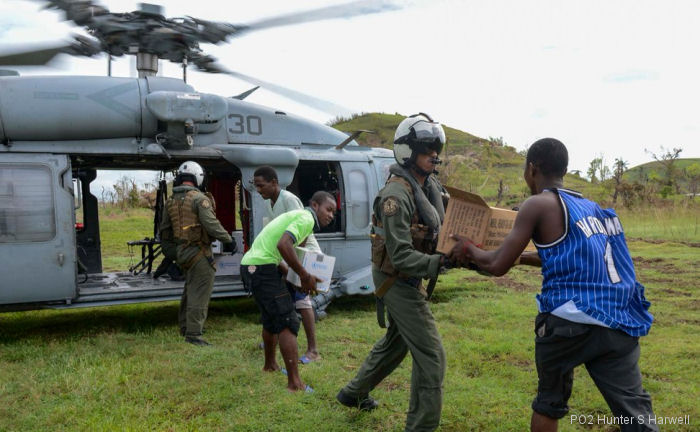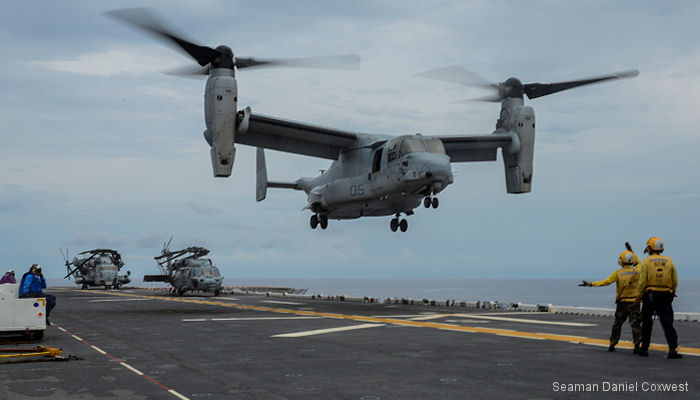US Navy, October 24, 2016 - NORFOLK - Sailors and Marines returned to Naval Station Norfolk aboard amphibious assault ship USS Iwo Jima (LHD 7) to offload personnel and equipment Oct. 24 after conducting humanitarian assistance and disaster relief as part of Joint Task Force (JTF) Matthew.
JTF-Matthew, led by Rear Adm. Roy Kitchener, commander of Expeditionary Strike Group 2, provided support to the U.S. Agency for International Development's (USAID) Office of Foreign Disaster Assistance (OFDA) in their efforts to provide immediate humanitarian and disaster relief assistance in the wake of Hurricane Matthew.
The deadly hurricane made landfall in Haiti Oct. 4, killing hundreds. U.S. military forces were already steaming toward Haiti when it struck, arriving just hours afterward.
Overall, JTF-Matthew conducted 400 hours of flight operations and delivered more than 600,000 lbs. of humanitarian relief supplies to some of the most impacted areas of the storm, directly aiding an estimated 100,000 citizens in the process.
"The military response helped the USAID-led team ramp up capability and capacity at the request of the government of Haiti," said Kitchener. "Humanitarian assistance and supplies are getting to the right areas, but the recovery effort in Haiti is far from over."
The Honorable Peter Mulrean, U.S. ambassador to Haiti, praised the military members of JTF-Matthew for their efforts in the operation and their quick action for a neighboring country in need.
"Your ability to pull together the perfect mix of personnel and assets, whether from Honduras, Norfolk, Miami or elsewhere, is what makes the U.S. military unique in its ability to provide rapid and targeted response," said Mulrean. "You have once again answered the call to help the people of Haiti, and have contributed to the great partnership that exists between our two countries."
Some of the JTF-Matthew forces had to accomplish the mission while also dealing with issues ashore, as their family members and friends weathered Hurricane Matthew back home.
"This mission had an additional factor that we had to pay attention to, in that our families at our homeport were directly affected by the same devastating storm," said Capt. James Midkiff, commanding officer of Iwo Jima. "I am both grateful and inspired by the way our families, our ombudsmen, and the Navy community pulled together to take care of each other. Their efforts allowed us to concentrate on our mission, knowing our friends' and loved ones' health and welfare back home were well taken care of. For some, this was their first time integrating with other naval and Marine Corps units, and I am so proud of what everyone accomplished throughout the entire operation."
The ability to go ashore and assist those in need was one of the highlights for military personnel.
"I definitely feel like every one of us has made an impact on Haiti," said Seaman Anthony Hughes of Iwo Jima. "I feel like what we did is a great thing for the people there and it helped save a lot of lives."
The first to arrive in Haiti was the Honduras-based Special Purpose Marine Air-Ground Task Force, Oct. 7, led by then JTF Commander Rear Adm. Cedric Pringle. They were followed shortly thereafter by ESG-2, composed of amphibious ship USS Mesa Verde (LPD 19), Iwo Jima, the 24th Marine Expeditionary Unit, Naval Beach Group 2 units, Tactical Air Control Squadron 21, Helicopter Sea Combat Squadron 28, Fleet Surgical Teams 4 and 8, and members of Navy Expeditionary Combat Command.
The amphibious-based JTF provided medium- and heavy-lift helicopters to carry large relief supply loads in the western part of Haiti, which was hardest hit.
"When you think of an expeditionary strike group, you think of its ability to deploy quickly and reach anywhere in the world with a game-changing military capability," said Kitchener. "Those same capabilities that make amphibious forces so powerful in combat also make them extremely effective conducting humanitarian assistance and disaster relief."
The Department of Defense has a longstanding history of providing initial support and capabilities to disaster relief efforts until governmental agencies and non-governmental organizations are able to provide the needed aid on their own.
Once JTF-Matthew's unique capabilities were no longer required, the JTF ceased operations Oct. 21 and transitioned the longer-term relief effort to the appropriate civilian agencies.
JTF-Matthew, led by Rear Adm. Roy Kitchener, commander of Expeditionary Strike Group 2, provided support to the U.S. Agency for International Development's (USAID) Office of Foreign Disaster Assistance (OFDA) in their efforts to provide immediate humanitarian and disaster relief assistance in the wake of Hurricane Matthew.
The deadly hurricane made landfall in Haiti Oct. 4, killing hundreds. U.S. military forces were already steaming toward Haiti when it struck, arriving just hours afterward.
Overall, JTF-Matthew conducted 400 hours of flight operations and delivered more than 600,000 lbs. of humanitarian relief supplies to some of the most impacted areas of the storm, directly aiding an estimated 100,000 citizens in the process.
"The military response helped the USAID-led team ramp up capability and capacity at the request of the government of Haiti," said Kitchener. "Humanitarian assistance and supplies are getting to the right areas, but the recovery effort in Haiti is far from over."
The Honorable Peter Mulrean, U.S. ambassador to Haiti, praised the military members of JTF-Matthew for their efforts in the operation and their quick action for a neighboring country in need.
"Your ability to pull together the perfect mix of personnel and assets, whether from Honduras, Norfolk, Miami or elsewhere, is what makes the U.S. military unique in its ability to provide rapid and targeted response," said Mulrean. "You have once again answered the call to help the people of Haiti, and have contributed to the great partnership that exists between our two countries."
Some of the JTF-Matthew forces had to accomplish the mission while also dealing with issues ashore, as their family members and friends weathered Hurricane Matthew back home.
"This mission had an additional factor that we had to pay attention to, in that our families at our homeport were directly affected by the same devastating storm," said Capt. James Midkiff, commanding officer of Iwo Jima. "I am both grateful and inspired by the way our families, our ombudsmen, and the Navy community pulled together to take care of each other. Their efforts allowed us to concentrate on our mission, knowing our friends' and loved ones' health and welfare back home were well taken care of. For some, this was their first time integrating with other naval and Marine Corps units, and I am so proud of what everyone accomplished throughout the entire operation."
The ability to go ashore and assist those in need was one of the highlights for military personnel.
"I definitely feel like every one of us has made an impact on Haiti," said Seaman Anthony Hughes of Iwo Jima. "I feel like what we did is a great thing for the people there and it helped save a lot of lives."
The first to arrive in Haiti was the Honduras-based Special Purpose Marine Air-Ground Task Force, Oct. 7, led by then JTF Commander Rear Adm. Cedric Pringle. They were followed shortly thereafter by ESG-2, composed of amphibious ship USS Mesa Verde (LPD 19), Iwo Jima, the 24th Marine Expeditionary Unit, Naval Beach Group 2 units, Tactical Air Control Squadron 21, Helicopter Sea Combat Squadron 28, Fleet Surgical Teams 4 and 8, and members of Navy Expeditionary Combat Command.
The amphibious-based JTF provided medium- and heavy-lift helicopters to carry large relief supply loads in the western part of Haiti, which was hardest hit.
"When you think of an expeditionary strike group, you think of its ability to deploy quickly and reach anywhere in the world with a game-changing military capability," said Kitchener. "Those same capabilities that make amphibious forces so powerful in combat also make them extremely effective conducting humanitarian assistance and disaster relief."
The Department of Defense has a longstanding history of providing initial support and capabilities to disaster relief efforts until governmental agencies and non-governmental organizations are able to provide the needed aid on their own.
Once JTF-Matthew's unique capabilities were no longer required, the JTF ceased operations Oct. 21 and transitioned the longer-term relief effort to the appropriate civilian agencies.
See also |
Hurricane Matthew relief operations
VMM-365
USS Iwo Jima to Haiti for Hurricane Matthew Relief






